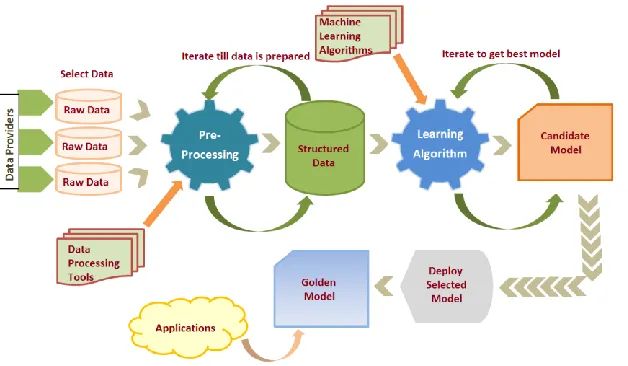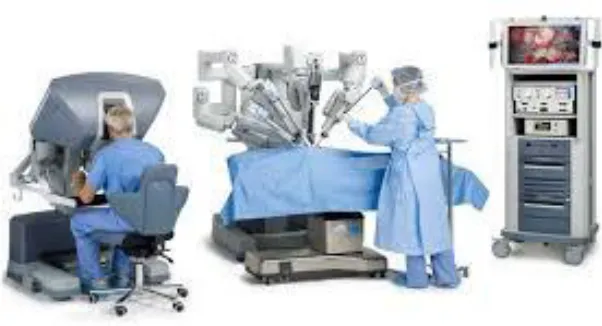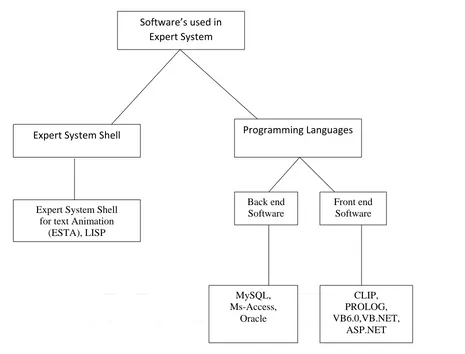GSJ: Volume 7, Issue 11, November 2019, Online: ISSN 2320-9186
www.globalscientificjournal.com
IMPACT OF EXPERT SYSTEM IN OUR GLOBAL
WORLD
Euphemia Chioma Nwokorie, Okoro Ugochukwu Bethel
Computer Science Department, Federal University of Technology, Owerri
Imo State, Nigeria cenwokorie@gmail.com
Computer Science Department,
Michael Okpara University of Agriculture, Umudike Umuahia, Abia State, Nigeria
Ugochukwubethel1988@gmail.com
Abstract: Use of computing equipment together with telecommunication infrastructure brings novel capabilities in our global world. An expert system is a computer program that uses artificial intelligence technologies to simulate the judgment and behavior of a human or an organization that has expert knowledge and experience in a particular field. An expert system is made up of three primary components. These are the inference engine, the knowledge base, and the user interface. Agricultural production system has progressed in to a complex business that requires the incorporation of knowledge and information from many various sources. The modern often depends on advisors and agricultural specialists to obtain information for the purpose of decision making. This research work centers on expert system as an off shoot of artificial intelligence, branches of artificial intelligence such as video game, hybrid intelligent systems, intelligent agent, machine learning, robotics, expert system etc., the historical background of expert system, application of expert system in education, auditing, agriculture, smart computing, virtual reality etc. it further discusses software tools needed.
Introduction
1.1 Background to the Study
In artificial intelligence, an expert system is a computer system that emulates the decision-making ability of a human expert. (Magdalena Les, 2015) Expert systems are designed to solve complex problems by reasoning through bodies of knowledge, represented mainly as if–then rules rather than through conventional procedural code. The first expert systems were created in the 1970s and then proliferated in the 1980s (Yang Liu, 2018). Expert systems were among the first truly successful forms of artificial intelligence (AI) software (Ryan, 2014).
Artificial intelligence (AI) is an area of computer science that emphasizes the creation of intelligent machines that work and react like humans. Some of the activities computers with artificial intelligence are designed to include speech recognition, Learning, Planning, monitoring Problem solving, Robots.
1.2 Branches of Artificial Intelligence
1.2.1 Video Game Artificial Intelligence
In video games, artificial intelligence is used to generate responsive, adaptive or intelligent behaviors primarily in non-player characters (NPCs), similar to human-like intelligence. The techniques used typically draw upon existing methods from the field of artificial intelligence (AI).
A video game is an electronic game that involves interaction with a user interface to generate visual feedback on a video device such as a TV screen or computer monitor.
Fig 1.1. A screenshot showing artificial intelligence game with machine learning: AI learns Mario level in just 34 attempts (source engadget.com)
1.2.2 Hybrid Intelligent System
Hybrid intelligent system denotes a software system which employs, in parallel, a combination of methods and techniques from artificial intelligence subfields as Neuro-fuzzy systems, hybrid connectionist-symbolic models, Fuzzy expert systems, Connectionist expert systems, Evolutionary neural networks, Genetic fuzzy systems, Rough fuzzy hybridization, Reinforcement learning with fuzzy, neural, or evolutionary methods as well as symbolic reasoning methods.
1.2.3 Intelligent Agent
In artificial intelligence, an intelligent agent (IA) is an autonomous entity which observes through sensors and acts upon an environment using actuators (i.e. it is an agent) and directs its activity towards achieving goals. Intelligent agents may also learn or use knowledge to achieve their goals. They may be very simple or very complex. A reflex machine, such as a thermostat, is considered an example of an intelligent agent.
1.2.4 Machine Learning
Machine learning is a field of artificial intelligence that uses statistical techniques to give computer systems the ability to learn (e.g., progressively improve performance on a specific task) from data, without being explicitly programmed.
Fig 1.2. A diagrammatic representation of machine learning process (source imarticus.org)
1.2.5 Natural language processing
Natural language processing (NLP) is a subfield of computer science, information engineering, and artificial intelligence concerned with the interactions between computers and human (natural) languages, in particular how to program computers to process and analyze large amounts of natural language data.
Challenges in natural language processing frequently involve speech recognition, natural language understanding, and natural language generation.
1.2.6 Robotics
Robotics is an interdisciplinary branch of engineering and science that
includes mechanical engineering, electronics engineering, information
engineering, computer science, and others. Robotics deals with the design, construction, operation, and use of robots, as well as computer systems for their control, sensory feedback, and information processing.
cognition, and basically anything a human can do. Many of today's robots are inspired by nature, contributing to the field of bio-inspired robotics.
Fig. 1.3. A diagram showing how robot is used in a surgery (source ecancer.org)
1.3 Expert System
Expert systems are computer applications developed to solve complex problems in a particular domain, at the level of extra-ordinary human intelligence and expertise.
This new era of information and communication technology has played a pivotal role in the field of expert systems. Web technologies allow knowledge engineers and domain experts to build expert systems that are having dynamic knowledge-base capabilities. Domain experts could update the knowledge at the central servers and users have an access to recent knowledge through web interface. Once the expert system is developed the domain experts require minimal intervention of programmer.
Nigeria as a sovereign state is naturally endowed with abundant resources, including both human and material resources (Olajide, Akinlabi & Tijai, 2012). The nation's resources need to be fully developed in such a manner that is possible with the mineral deposits of the nation as a whole, which can only be harnessed by rational and efficient utilization of the natural resources. Thus, the importance of resources in any given economy depends on the roles such resources play in economic growth and development of the nation. In developing economies like Nigeria, agriculture constitutes backbone and critical sector of the economy, as the contributions of the sector to the growth and sustainable development of the country cannot be overemphasized.
agriculture and economic growth in his book “The Agricultural Sector in Nigeria: The Way Forward” in 1997 revealed that poor performance of economic growth in an economy especially, in the developing economies is due to slump in agricultural sector performance (Erokhin, 2017). Agricultural sector in Nigeria has overtime become an important sector of the economy. It has remained the main sector of Nigerian economy despite the discovery of oil in commercial quantities and its attendant boom since 1970s. For example, despite agricultural sector neglect by government at the emergence of oil in 1970s, the sector remained the major employment segment of the economy thereby employing over 60% of the unemployed workforce in country, reduces extreme poverty and as well promotes economic growth of the economy (Oji-Okoro, 2011). In the same view, Oluwasanmi H.A. in 1966 argued that efficient and strong agricultural sector strengthens countries to provide for its fast growing population, create jobs for their workforce, eradicate absolute poverty, feed industries with the required industrial raw materials, generates foreign exchange earnings and revenue to government. (Richard & Ehimika, 2018)
This means that agriculture is growth-led factor, which has multiplier effect on socio-economic and industrial development of any economy due to its various contributions to the growth of domestic economy. The sector’s contribution to total real gross domestic product (RGDP) ranges from 30% to 42%, and has as well engaged over 65% of the country’s total workforce. Agriculture constitutes the major occupation in the country. For example, nearly 70% of Nigerian population depend on Agriculture as a means of livelihood. As a result of this, research efforts are consciously directed toward the development of agriculture in Nigeria. Traditionally, developed agricultural innovations are dispersed to the farmers through field visits and on-farm demonstrations by the research and extension personnel (Blessing, 2012). Hence, a business or an industry employs the knowledge of various sciences in the production of food, feed, fiber and fuel. The definition therefore, recognizes the fact that plants and animals were originally grown and developed in an economy without human interference. But with the evolvement of agriculture, human quest to increase food production for the growing population emerged. In that, people began to exploit the growth of plants and animals to produce the type and quantity of food and other products that would meet needs of human population in the society. According to Ernest S.O. (2014), agriculture contributes to growth and development of an economy in four main ways, and these include product contribution, factor contribution, market contribution, as well as foreign exchange contribution.
1.4 Historical Background of Expert System
organic molecules. According to Edward Feigenbaum, (1977) the idea that intelligent systems derive their power from the knowledge they possess rather than from the specific formalisms and inference schemes they use was at the time a significant step forward. Expert systems became some of the first truly successful forms of artificial intelligence (AI) software (Van de Gevel & Charles, 2013).
Architecture of Expert System
Fig. 1.4. A diagram depicting how expert system works
Need of Expert System in Agriculture
Expert system as an information support
Technological advancement increased the degree of availability of information and it continues to grow at a phenomenal rate. Information is primarily required in agriculture, researches are carried out on daily basis and new results are revealed at research institutions and documented as reports and dissertations. Most of these results and recommendation do not reach farmers at implementation level. This is because there is a huge gulf between researchers and farmers as a result of lack of decision support system to disseminate on time pertinent farming advice. Advances in information communication technology provides good working framework for the dissemination of agricultural information, hence an expert system which can give personalized expert advice to a large community of farmers, according to their need considering various knowledge bases, since it is virtually impossible for any human expert to consider every piece of available information before arriving at optimal decisions (Yelapure et al, 2012).
Expert system for making decisions
are the machine equivalent of human experts. The expert system works with cognitive approach and stress the knowledge in knowledge base which is a separate component. So that changes in knowledge do not change whole structure of expert system. Another advantage is reasoning capability. They can explain reasons for arriving at particular decision (Yelapure et al, 2012).
1.5 Software tools Used in Expert System
The expert system developed by various experts clearly indicate that different software were used to develop computer based expert system for different applications. There are two ways of building expert system: one is to develop from scratch, that is, to code the expert system as a normal computer program for each domain using programming languages like CLIPS, PROLOG, LISP, VB 6.0, VB.Net, ASP.Net, PHP, Java, C#, Python etc as frontend, MS Access, MySQL, ORACLE etc as backend and the other is to use an expert system shell, that is, to build an expert system with the help of specially designed programs that are commercially available which may be used for a particular domain. The shell enables the user to build their own expert system with or without the help from knowledge engineers. Thus shells can make considerable saving on programming time. Because of this, building expert system can be faster and more commercial.
Fig 1.5. A flow diagram showing a Schematic representation for the languages used in expert system.
1.6 Applications of Expert System
Smart Computing
Self-Monitoring, Analysis, and Reporting Technology (SMART) is a monitoring system for computer hard disks to detect and report on various indicators of reliability, so as to anticipate failures. It is a system BIOS and hard disk feature that monitors its performance, disk spin up time, temperature, distance between the head and the disk, and other mechanical activities of the hard disk so as to predict when the disk is likely to fail (Jean, 2009).
The idea behind SMART is that many hard disk are predictable, and that computer users, given a heads-up that their hard disk is on the verge of failing, will be able to recover data before the failure actually happens (Chris, 2009).
It is estimated that over 94% of all new information produced in the world is stored on magnetic media, most of it on physical disks. The drive vendors builds a logic into the
Software’s used in Expert System
Programming Languages Expert System Shell
Front end Software Back end
Software Expert System Shell
for text Animation (ESTA), LISP
CLIP, PROLOG, VB6.0,VB.NET,
ASP.NET MySQL,
drives to make them smart so that the user gets warning signal as a predictive failure whenever the drive is about to go bad. The drive monitors the number of error checking and correction (ECC) and based on the data analyzed, it can predict failures (Venugopal & Patnaik, 2011).
In recent years, with the first development of smart transport system and data collection technology, a large amount of transit smart card has been accumulated. The transit smart card data has the advantage of detecting residents travel activities. It is computerized without human input like household survey, and it records travelers travel data in daily, monthly and yearly period and could reflect many travel details (Meikang, 2018).
Networking devices such as routers, brouters and switches have been made smart. Routers have the ability to learn addresses of computers and store them in their routing tables and determine the best part to send packets. More so, network switches learn and store mapping relationship between mac addresses and switch port in their mac table, this enable the switches to make decisions with respect to which computer to forward data (Navaid et al, 2015).
Virtual Reality
Virtual reality is a system that enables one or more users to move and react in a computer simulated environment. The term virtual reality was initially coined in 1989 by Jaron Lanier. Originally the term referred to immersive virtual reality in which the user becomes fully immersed into an artificial, 3D world that is completely generated by a computer. Through immersion the user can gain a deeper understanding of the virtual world’s behavior and functionality. A wide range of virtual reality based application such as immersive education, real-time visualization of complex data (such as medical, engineering, weather), telemedicine (such as drug design, medical imaging, and remote surgery), immersive multiplayer games, and vehicle and aircraft design and simulation (Ralph & George, 2013).
Virtual reality simulations require special interface devices that transmit the site, sound and sensations of the simulated world to the user. These devices can also record and send the speech and movements of the participant to the simulation program, which enable users to sense and manipulate virtual object much as they would to real objects. This natural style of interaction gives the participants the feeling that they are immersed in a simulated world. For instance, an auto manufacturer can use virtual reality to help it simulate and design factories (Stair & Reynolds, 2013).
The World Wide Web (WWW) has been a revolution on the computing field since 1990. Expert system developers realize the value to be gained by connecting their knowledge bases to the WWW interface. At the simple end, an expert system uses text-based WWW interfaces to replace a text based interface that would be delivered in some other more proprietary way. For example, a lymph node expert system was developed in a class project and it is accessible on the WWW. At the other end, researchers are developing virtual reality interfaces on top of the WWW that allows the user to be immersed in the environment upon which the expert system is giving advice. For example, in ship emergency handling with expert system support, a virtual reality interface supported on the WWW can be valuable.
Agriculture
Agricultural production system has been progressing into a compound business system that requires the incorporation of knowledge and information from many various sources. In order to remain competitive, the modern farmer often relies on agricultural specialists and advisors to get information for decision making. Unfortunately, assistance of the agricultural expert is not always available when the farmer needs it. In order to assuage this problem, expert systems which emulates the decision making ability of human experts (Kumar, 2014) were identified as a powerful tool with extensive potential in agriculture.
References
Li Deng & Yang Liu (2018). Deep Learning in Natural Language Processing, PP 3, ISBN 978-891-10-5208-8.
Nishith P. & Anurag B. (2018). IoT, AI, and Blockchain for .NET: Building a Next-Generation Application. Chapter 1, pp 7, ISBN 978-1-4842-3709-0.
Richard A. O. & Ehimika A. I. (2018). Contemporary Issues in Africa's Development: Whither the African Renaissance? Chapter 6, pp 126. ISBN (13): 978-1-5275-0336-2.
Manohar S. (2017). Mastering Machine Learning with Python in Six Steps: A Practical Implementation Guide To Predictive Data Analytics Using Python. Step2: Introduction to machine learning. Pp 53, ISBN 978-1-4842-2866-1.
Meikang Q (2018). Smart Computing and Communication: Second International Conference, SmartCom 2017, Shenzhen, China, December 10-12, 2017 proceedings. Pp 12, ISBN 978-3-319-73829-1.
Erokhin, V. (2017). Establishing Food Security and Alternatives to International Trade in Emerging Economies. ISBN 9781522527336.
Ernest S.O. (2014). The macroeconomic policy effecton Nigerian agricultural performance: One-stepdynamic forecasting analysis. International Journal of Economics and Finance.6(9):12-23.
Ryan. (2014). The Digital Mind: An Exploration of artificial intelligence, Chapter 4. Van de Gevel & Charles N. N. (2013). The Nexus between Artificial Intelligence and
Economics. PP 27, ISBN 978-3-642-33647-8.
Olajide O.T, Akinlabi B.H, & Tijai AA.(2012). Agriculture resource and economic growth in Nigeria. European Scientific Journal. 2012;8(22):98-112.



